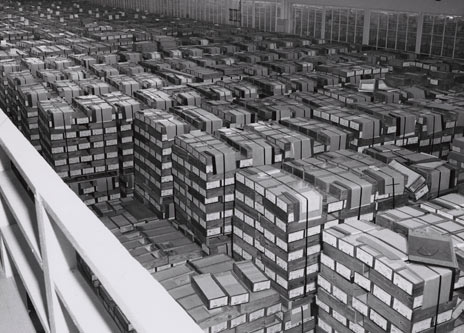
I pulled out an old textbook in June of '09 and the above-depicted
card fell out. The card likely dates to the late '70s and an
undergraduate CS course at Virginia Tech.
My guess is that most students have not seen punch cards of this
sort. This one includes a word, likely a variable name at the
beginning of an unfinished PL/I assignment statement. Why PL/I and
not FORTRAN? The predominant FORTRAN compiler on the IBM 370/158
at Tech in that era was not yet FORTRAN 77, and
so QUANTITY is too long to have been a FORTRAN variable
name.
 With seven distinct letters, the word quantity provides
enough information to suggest that the encoding was
probably EBCD
(an EBCDIC subset). The encoding is summarized to the right.
Reading the card: the rows 0-9 are clearly marked. The top row
is Y, and the row below that is X. The encoding
scheme places zero to three holes per column. A column with no
holes indicates a space and in the diagram is indicated
by - for both row and column. In the example card, every
column without a letter is a space—no holes.
With seven distinct letters, the word quantity provides
enough information to suggest that the encoding was
probably EBCD
(an EBCDIC subset). The encoding is summarized to the right.
Reading the card: the rows 0-9 are clearly marked. The top row
is Y, and the row below that is X. The encoding
scheme places zero to three holes per column. A column with no
holes indicates a space and in the diagram is indicated
by - for both row and column. In the example card, every
column without a letter is a space—no holes.
On the card, look at the column below the letter 'U'. There are
two holes punched, one in row 0 and one in row 4. Looking at the
encoding in the table, 0-4 is 'U'. Look at the column under the
'A'. Rows Y and 1 are punched, indicating, in the table,
'A'. Certain punctuation characters require three holes. An
example of this is '*', which uses 8, 4, and X.
Notice that, including space, EBCD allows for 64 different
characters. The ones chosen are the most important ones for
programming in an all uppercase world. On the face of it, so to
speak, a card could accommodate a larger character set since 12
rows would correspond to 12-bit characters, allowing 4096
combinations. However, a
Wikipedia article
points out that more holes per column can endanger the structural
strength of the card. One possible benefit of a richer character
set would be lowercase letters. Another would be filling the chaff
tray (where punched out holes reside until the card punch is
cleaned out) faster, providing larger quantities of confetti for
dormitory use.
For comparison, below is a FORTRAN statement on a card found
at Wikipedia. Does
this card use the same encoding as the card above?
 To the
right is a
scene reportedly
from a National Archives storage facility taken in 1959. From Wikipedia:
Storage of IBM record cards at the Federal records center in
Alexandria, Virginia, November 1959. Between 1950 and 1966 the records
centers received millions of cubic feet of records, saving the federal
government more than the total spent for the entire operation of the
National Archives Records Service. Note: There are about 20 rows of
pallets visible, each row is 15 pallets wide, pallets are stacked two
high (at least). Each pallet contains 45 boxes of punched
cards. Standard card boxes contained 2000 cards. Each card held up to 80
characters, for a total of about 4.3 billion characters of data in
storage [in] this facility.
To the
right is a
scene reportedly
from a National Archives storage facility taken in 1959. From Wikipedia:
Storage of IBM record cards at the Federal records center in
Alexandria, Virginia, November 1959. Between 1950 and 1966 the records
centers received millions of cubic feet of records, saving the federal
government more than the total spent for the entire operation of the
National Archives Records Service. Note: There are about 20 rows of
pallets visible, each row is 15 pallets wide, pallets are stacked two
high (at least). Each pallet contains 45 boxes of punched
cards. Standard card boxes contained 2000 cards. Each card held up to 80
characters, for a total of about 4.3 billion characters of data in
storage [in] this facility.
 With seven distinct letters, the word quantity provides
enough information to suggest that the encoding was
probably EBCD
(an EBCDIC subset). The encoding is summarized to the right.
Reading the card: the rows 0-9 are clearly marked. The top row
is Y, and the row below that is X. The encoding
scheme places zero to three holes per column. A column with no
holes indicates a space and in the diagram is indicated
by - for both row and column. In the example card, every
column without a letter is a space—no holes.
With seven distinct letters, the word quantity provides
enough information to suggest that the encoding was
probably EBCD
(an EBCDIC subset). The encoding is summarized to the right.
Reading the card: the rows 0-9 are clearly marked. The top row
is Y, and the row below that is X. The encoding
scheme places zero to three holes per column. A column with no
holes indicates a space and in the diagram is indicated
by - for both row and column. In the example card, every
column without a letter is a space—no holes.


 To the
right is a
scene
To the
right is a
scene